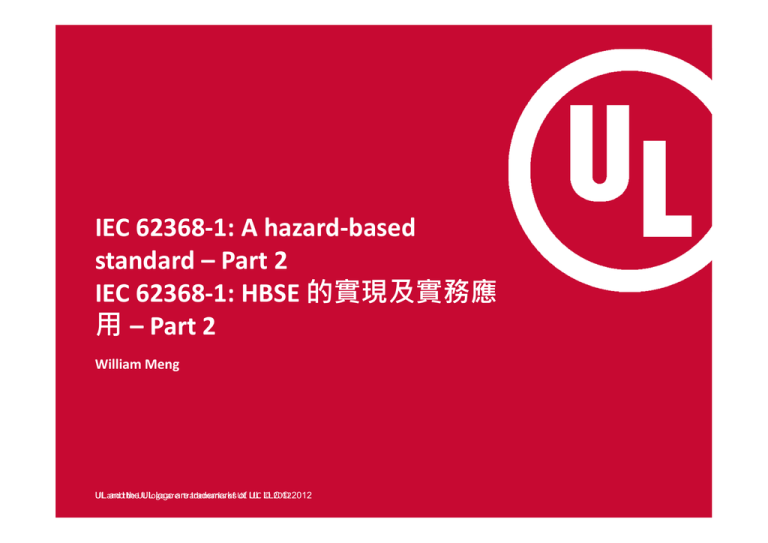
IEC 62368‐1: A hazard‐based standard – Part 2
IEC 62368‐1: HBSE 的實現及實務應
用 – Part 2
William Meng
UL and the UL logo are trademarks of UL LLC © 2012
UL
and the UL logo are trademarks of UL LLC © 2012
Outline
•
•
•
Concept change of IEC 62368‐1
Electrically‐caused injury
Mechanically‐caused injury
2
Concept change of IEC 62368‐1
Innovation of IEC 62368‐1
•
Introduces models
•
Introduces the concept of safeguards
model for injury
basic safeguard
model for safety
supplementary safeguard
reinforced safeguard
•
Classifies energy sources
class 1: may be detectable
class 2: may be painful
class 3: capable of causing injury
•
Applies safeguards based on persons
ordinary person
instructed person
skilled person
Copyright © 2011 Underwriters Laboratories Inc.
All Rights Reserved. Do Not Reproduce without Permission.
4
Discarded requirements of IEC 60950‐1
•
Energy hazard
What’s the injury caused?
•
Functional insulation
“Functional” insulation does not provide protection
•
Functional earthing
“Functional” earthing does not provide protection
5
Electrically‐caused Injury
Transfer mechanism – Current pass through the human body
Transfer mechanism – Current pass through the human body (cont.)
Safeguard: interposed between human body and sources of hazard
Copyright © 2011 Underwriters Laboratories Inc.
All Rights Reserved. Do Not Reproduce without Permission.
Current
Class of electrical energy level
ES3: injury
ES2: painful, but no injury
ES1: sensation/perception, but no pain
Voltage
Class of electrical energy sources and safeguard
•
What are ES1, ES2, and ES3??
ES class ‐ steady state AC current
•
ES1
< 30 Vrms, or < 0.5 mArms
ES2
< 50 Vrms, or < 5 mArms
ES3
> ES2
What are safeguard for protection against ES??
Safeguard
against ES
ES1
None
ES2
Basic insulation
ES3
Double or
reinforced insulation
11
Practical application – Power supply
Capacitor discharge
Capacitor discharge
Combination of voltage
and capacitance
13
Review of standard requirements
137.35 V @ 1 sec. after unplug
Complied, but safe?
50.53 V @ 2 sec. after unplug
14
Practical application – Power supply (cont.)
Identify the energy source
Is the energy
hazardous?
Components bridging insulation: transformers, Y‐cap, opto‐couplers
NO
YES
Identify transfer mechanism:
Insulation: spacing
accessibility
Design safeguards that prevents the transfer of energy (to a body part)
ES1
ES3
Interposed between energy sources and body
Evaluate its
effectiveness
NO
Is the safeguard
effective?
YES
Done
Insulation: tubing
Insulation (sheet)
Effectiveness of safeguard:
• Construction, and/or
• Performance
Practical application – Power supply (cont.)
Safeguard interposed between hazards and body: Earthed enclosure
Access to internal hazardous parts is not likely through openings
Clearances
Steady state, including:
• (Internally‐generated) Working voltage
• Mains supply voltage
• High‐freq. working voltage
External disturbance:
• Transient overvoltage
• Temp. overvoltage
18
AC mains transient: 2,500 Vpk
Working voltage: 640 Vpk
R/I: 4.6 mm
Conductor
AC mains transient: 2,500 Vpk
Working voltage: 420 Vpk
R/I: 4.0 mm
PWB
Can a shorter air insulation be used?
19
High frequency voltage stress on insulation
•
Affect clearances and solid insulation
- Spacing: required clearance is longer
- Solid insulation: material deterioration
0.9
Phenolic
Reduction factor
0.8
Teflon
0.7
Mica
0.6
Polyethylene
0.5
0.4
0.3
0.2
0.1
10
100
Frequency (kHz) 1,000
10,000
Mechanically‐caused injury
Practical application – Server
22
Practical application – Server (DC fans)
MS3
Identify the energy source
Is the energy
hazardous?
NO
MS1
YES
Identify transfer mechanism:
accessibility: persons, conditions
Design safeguards that prevents the transfer of energy (to a body part)
Physical safeguard or marking
Evaluate its
effectiveness
NO
Is the safeguard
effective?
YES
Done
MS class of moving fan blade is dominated by:
• Mass of moving fan blade (rotor)
• Dimension of fan blade
• Fan speed
• Material (under discussion)
Equipment stability – with presence of children
Practical application – carts or stands (with “cargo”)
Identify the energy source
Is the energy
hazardous?
NO
YES
Identify transfer mechanism:
physical contact with body
Design safeguards that prevents the transfer of energy (to a body part)
Robustness of casters, stability of equipment plus carts
Evaluate its
effectiveness
NO
Is the safeguard
effective?
YES
Done
MS1: <= 7 kg
MS2: 7 kg < mass <= 25 kg
MS3: > 25 kg
Pull force test
Horizontal force
Relocation stability
25
THANK YOU.


